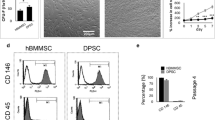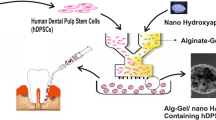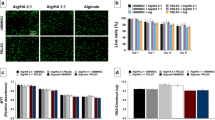Abstract
The objectives of this study were to: (1) develop an injectable and biodegradable scaffold based on oxidized alginate microbeads encapsulating periodontal ligament (PDLSCs) and gingival mesenchymal stem cells (GMSCs); and (2) investigate the stem cell viability, and osteogenic differentiation of the stem cells in vitro. Stem cells were encapsulated using alginate hydrogel. The stem cell viability, proliferation and differentiation to adipogenic and osteogenic tissues were studied. To investigate the expression of both adipogenesis and ontogenesis related genes, the RNA was extracted and RT-PCR was performed. The degradation behavior of hydrogel based on oxidized sodium alginate with different degrees of oxidation was studied in PBS at 37 °C as a function of time by monitoring the changes in weight loss. The swelling kinetics of alginate hydrogel was also investigated. The results showed that alginate is a promising candidate as a non-toxic scaffold for PDLSCs and GMSCs. It also has the ability to direct the differentiation of these stem cells to osteogenic and adipogenic tissues as compared to the control group in vitro. The encapsulated stem cells remained viable in vitro and both osteo-differentiated and adipo-differentiated after 4 weeks of culturing in the induction media. It was found that the degradation profile and swelling kinetics of alginate hydrogel strongly depends on the degree of oxidation showing its tunable chemistry and degradation rate. These findings demonstrate for the first time that immobilization of PDLSCs and GMSCs in the alginate microspheres provides a promising strategy for bone tissue engineering.








Similar content being viewed by others
References
Porter JR, Ruckh TT, Popat KC. Bone tissue engineering: a review in bone biomimetics and drug delivery strategies. Biotechnol Prog. 2009;25:1539–60.
Betz VM, Betz OB, Harris MB, Vrahas MS, Evans CH. Bone tissue engineering and repair by gene therapy. Front Biosci. 2008;13:833–41.
Arrington ED, Smith WJ, Chambers HG, Bucknell AL, Davino NA. Complications of iliac crest bone graft harvesting. Clin Orthop Relat Res. 1996;329:300–9.
Parfitt AM. The cellular basis of bone remodeling: the quantum concept reexamined in light of recent advances in the cell biology of bone. Calcif Tissue Int. 1984;36(Suppl 1):S37–45.
Jiang T, Abdel-Fattah WI, Laurencin CT. In vitro evaluation of chitosan/poly (lactic acid-glycolic acid) sintered microsphere scaffolds for bone tissue engineering. Biomaterials. 2006;27:4894–903.
Chung YI, Ahn KM, Jeon SH, Lee SY, Lee JH, Tae G. Enhanced bone regeneration with BMP-2 loaded functional nanoparticle-hydrogel complex. J Control Release. 2007;121:91–9.
van den Dolder J, Farber E, Spauwen PH, Jansen JA. Bone tissue reconstruction using titanium fiber mesh combined with rat bone marrow stromal cells. Biomaterials. 2003;24:1745–50.
Mauney JR, Volloch V, Kaplan DL. Role of adult mesenchymal stem cells in bone tissue engineering applications: current status and future prospects. Tissue Eng. 2005;11:787–802.
Sachlos E, Czernuszka JT. Making tissue engineering scaffolds work. Review on the application of solid freeform fabrication technology to the production of tissue engineering scaffold. Eur Cells Mater. 2003;5:29–40.
Monaco E, Bionaz M, Hollister SJ, Wheeler MB. Strategies for regeneration of the bone using porcine adult adipose-derived mesenchymal stem cells. Theriogenology. 2011;75:1381–99.
Gronthos S, Mankani M, Brahim J, Robey PG, Shi S. Postnatal human dental pulp stem cells (DPSCs) in vitro and in vivo. PNAS. 2000;97:13625–30.
Miura M, Gronthos S, Zhao M, Lu B, Fisher LW, Robey PG, Shi S. SHED: stem cells from human exfoliated deciduous teeth. PNAS. 2003;100:5807–12.
Seo BM, Miura M, Gronthos S, Bartold PM, Batouli S, Brahim J, et al. Investigation of multipotent postnatal stem cells from human periodontal ligament. Lancet. 2004;364:149–1155.
Sonoyama W, Liu Y, Yamaza T, Tuan RS, Wang S, Shi S, et al. Characterization of the apical papilla and its residing stem cells from human immature permanent teeth: a pilot study. J Endod 2008;34:166–71.
Zhang Q, Shi S, Liu Y, Uyanne J, Shi Y, Shi S, et al. Mesenchymal stem cells derived from human gingiva are capable of immunomodulatory functions and ameliorate inflammation-related tissue destruction in experimental colitis. J Immunol. 2009;183:7787–98.
Mitrano TI, Grob MS, Carrion F, Nova-Lamperti E, Luz PA, Fierro FS, et al. Culture and characterization of mesenchymal stem cells from human gingival tissue. J Periodontol. 2010;81:917–25.
Poncelet D, Lencki R, Beaulieu C, Halle JP, Neufeld RJ, Fournier A. Production of alginate beads by emulsification/internal gelation. I. Methodology. Appl Microbiol Biotechnol. 1992;39:39–45.
Drury JL, Dennis RG, Mooney DJ. The tensile properties of alginate hydrogels. Biomaterials. 2004;25:3187–99.
Wang TG. Polymer membranes for cell encapsulation. In: Kuhtreiber WM, Lanza RP, Chick WL, editors. Cell encapsulation technology and therapeutics. Boston: Birkhauser; 1999. p. 80–2.
Li P, Harrison D. Transport, manipulation, and reaction of biological cells on-chip using electrokinetic effects. J Anal Chem. 1997;70:1564–8.
Higasi T, Nagamori E, Sone T, Matsunaga S, Fukui K. A novel transfection method for mammalian cells using calcium alginate microbeads. J Biosci Bioeng. 2004;97:191–5.
Bunger CM, Tiefenbach B, Jahnke A, Gerlach C, Freier Rh, Schmitz KP, et al. Deletion of the tissue response against alginate-pll capsules by temporary release of co-encapsulated steroids. Biomaterials. 2005;26:2353–60.
Lee KY, Bouhadir KH, Mooney DJ. Controlled degradation of hydrogels using multi-functional cross-linking molecules. Biomaterials. 2004;25:2461–6.
Alsberg A, Anderson KW, Albeiruti A, Franceschi RT, Mooney DJ. Cell-interactive alginate hydrogels for bone tissue engineering. J Dent Res. 2001;80:2025–9.
Kuo CK, Ma PX. Ionically crosslinked alginate hydrogels as scaffolds for tissue engineering: Part 1. Structure, gelation rate and mechanical properties. Biomaterials 2001;22:511–521.
Gao C, Liu M, Chen J, Zhang X. Preparation and controlled degradation of oxidized sodium alginate hydrogel. Polym Degrad Stab. 2009;94:1405–10.
Weir MD, Xu HKK. Human bone marrow stem cell-encapsulating calcium phosphate scaffolds for bone repair. Acta Biomater. 2010;6:4118–26.
Moshaverinia A, Ansari S, Moshaverinia M, Roohpour N, Darr JA, Rehman IU. Effects of incorporation of hydroxyapatite and fluoroapatite nanobioceramics into conventional glass ionomer cements (GIC). Acta Biomater. 2008;4:432–40.
Evangelista MB, Hsiong SX, Fernandes R, Sampaio P, Kong H, Barrias CC, et al. Upregulation of bone cell differentiation through immobilization within a synthetic extracellular matrix. Biomaterials. 2007;28:3644–55.
Metters AT, Bowman CN, Anseth KS. A statistical kinetic model for the bulk degradation of PLA-b-PEG-b-PLA hydrogel networks. J Phys Chem B. 2000;104:7043–9.
Kuo CK, Ma PX. Maintaining dimensions and mechanical properties of ionically crosslinked alginate hydrogel scaffolds in vitro. J Biomed Mater Res. 2008;84:899–907.
Lee KY, Rowley JA, Eiselt P, Moy EM, Bouhadir KH, Mooney DJ. Controlling mechanical and swelling properties of alginate hydrogels independently by cross-linker type and cross-linking density. Macromolecules. 2000;33:4291–4.
Lee KY, Bouhadir KH, Mooney DJ. Degradation behavior of covalently cross-linked poly(aldehyde guluronate) hydrogels. Macromolecules. 2000;33:97–101.
Lee CSD, Moyer HR, Gittens RA, Williams JK, Boskey AL, Boyan BD, et al. Regulating in vivo calcification of alginate microbeads. Biomaterials. 2010;31:4926–34.
Tomar GB, Srivastava RK, Gupta N, Barhanpurkar AP, Pote ST, Jhaveri HM, et al. Human gingiva-derived mesenchymal stem cells are superior to bone marrow-derived mesenchymal stem cells for cell therapy in regenerative medicine. Biochem Biophys Res Commun. 2010;393:377–83.
Herrero EP, Del Valle EM, Galan MA. Immobilization of mesenchymal stem cells and monocytes in biocompatible microcapsules to cell therapy. Biotechnol Prog. 2007;23:940–5.
Masuda K, Sah RL, Hejna MJ, Thonar EJ. A novel two-step method for the formation of tissue-engineered cartilage by mature bovine chondrocytes: the alginate-recovered-chondrocyte (ARC) method. J Orthop Res. 2003;21:139–48.
Bouhadir KH, Mooney DJ. Synthesis of hydrogels: alginate hydrogels. In: Atala A, Lanza RP, editors. Methods of tissue engineering. New York: Academic Press; 2002, p. 653–662.
Boontheekul T, Kong H, Mooney D. Controlling alginate gels degradation utilizing partial oxidation and bimodal molecular weight distribution. Biomaterials. 2005;26:2455–65.
Author information
Authors and Affiliations
Corresponding author
Rights and permissions
About this article
Cite this article
Moshaverinia, A., Chen, C., Akiyama, K. et al. Alginate hydrogel as a promising scaffold for dental-derived stem cells: an in vitro study. J Mater Sci: Mater Med 23, 3041–3051 (2012). https://doi.org/10.1007/s10856-012-4759-3
Received:
Accepted:
Published:
Issue Date:
DOI: https://doi.org/10.1007/s10856-012-4759-3




